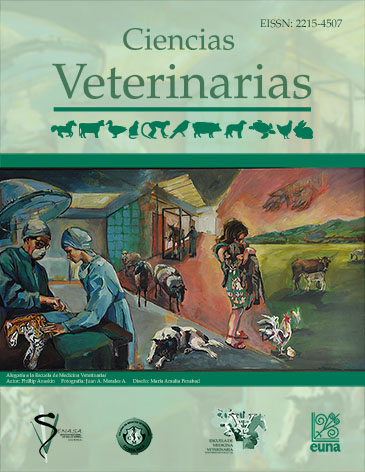Ultrasonographic measurement of the equine fetal vitreous body length for predicting days to parturition in Pura Raza Española horses
DOI:
https://doi.org/10.15359/rcv.37-2.1Keywords:
Pura Raza Española, Mares, Ocular, Diameter, Parturition, UltrasonographyAbstract
Ultrasonographic measurement of the fetal vitreous body length to predict parturition date in horses has shown substantial differences between breeds. PRE (Pura Raza Española or Purebred Spanish Horse) is an important breed in the equine industry of Costa Rica. No data for prediction of parturition exists for PRE using fetal ocular measurements. Between-observer agreement has never been evaluated for fetal ocular measurements on horses. A total of 86 ocular diameters were measured by a veterinarian in twelve PRE mares from day 240 of gestation until parturition. Forty measurements were repeated by a senior veterinary student to determine between-observer agreement. Transrectal ultrasonography was performed in each occasion, and a mean was calculated of the three measurements obtained. Two nonlinear regression equations were derived using days before parturition and age of gestation as dependent variables and vitreous body length as the independent variable. The model obtained for days before parturition was y = 1123.8 -55.5*x+0.689*x2, where “y” represents days before parturition and “x” represents fetal ocular diameter (r2= 0.79; P<0.001); and y = -710.6+51.8*x -0.644*x2, where “y” represents age of gestation and “x” represents ocular diameter (r2= 0.75; P<0.001). Pearson correlation coefficient and paired t-test were performed to assess the between-observer agreement. No significant differences (p=0.86) were detected between-observers, indicating high reproducibility. This study concluded that ocular diameter measurement can be reproduced with high precision by different veterinarians, and either model using days before parturition or age of gestation can be used to predict parturition in PRE mares when breeding dates are unknown.
References
Allen, W.R., Wilsher S., Stewart, F., Ousey, J. & Fowden, A. 2002. The influence of maternal size on placental, fetal and postnatal growth in the horse. II. Endocrinology of pregnancy. J Endocrinol; 172:237–46. doi:10.1677/joe.0.1720237
Bucca, S., Fogarty, U., Collins, A. & Small, V. 2005. Assessment of feto-placental well-being in the mare from mid-gestation to term: Transrectal and transabdominal ultrasonographic features. Theriogenology; 64:542–57. doi: 10.1016/j.theriogenology.2005.05.011
Hartwig, F.P., Antunez, L., Dos Santos, R.S., Lisboa, F.P., Pfeifer, L.F.M. & Nogueira, CEW. 2012. Determining the gestational age of crioulo mares based on a fetal ocular measure. J Equine Vet Sci; 33:557–60. doi: 10.1016/j.jevs.2012.08.203
Hendriks, W.K., Colenbrander, B., Van der Weijden, G.C. & Stout, T.A.E. 2009. Maternal age and parity influence ultrasonographic measurements of fetal growth in Dutch Warmblood mares. Anim Reprod Sci; 115:110–23. doi: 10.1016/j.anireprosci.2008.12.014
Henneke, D.R., Potter, G.D., Kreider, J.L. & Yeates, B.F. 1983. Relationship between condition score, physical measurements and body fat percentage in mares. Equine Vet J; 15:371–2. doi: https://doi.org/10.1111/j.2042-3306.1983.tb01826.x
Kahn, V.W. & Leidl, W. 1987. Die ultraschall-biometrie von pferdefeten in utero und die sonographische darstellung ihrer organe. Dtsch Tierarztl Wschr; 94:497–540
Lanci, A., Castagnetti, C., Ranciati, S., Sergio, C. & Mariella, J. 2018. A regression model including fetal orbit measurement to predict parturition in Standardbred mares with normal pregnancy. Theriogenology; 126:153–158. https://doi.org/10.1016/j.theriogenology.2018.12.020
Murase, H., Endo, Y., Tsuchiya, T., Kotoyori, Y., Shikichi, M. & Ito, K. 2014. Ultrasonographic Evaluation of Equine Fetal Growth Throughout Gestation in Normal Mares Using a Convex Transducer. J Vet Med Sci; 76:947–53. doi:10.1292/jvms.13-0259
Renaudin, C.D., Gillis, C.L., Tarantal, A.F. & Coleman, D.A. 2000. Evaluation of equine fetal growth from day 100 of gestation to parturition by ultrasonography. J Reprod Fertil; 56:651–60.
Rollins, C.E. & C. H.W. 1951. Environmental Sources of Variation in the Gestation Length of the Horse. J Anim Sci; 10:789–796. doi:https://doi.org/10.2527/jas1951.104789x
Turner, R.M., McDonnell, S.M., Feit, E.M., Grogan, E.H. & Foglia, R. 2006. Real-time ultrasound measure of the fetal eye (vitreous body) for prediction of parturition date in small ponies. Theriogenology; 66. doi: 10.1016/j.theriogenology.2005.11.019
Watson, P.F. & Petrie, A. 2010. Method agreement analysis: A review of correct methodology. Theriogenology; 73:1167–79. doi: 10.1016/j.theriogenology.2010.01.003
Published
How to Cite
Issue
Section
License
Licensing of articles
All articles will be published under a license:

Licencia Creative Commons Atribución-NoComercial-SinDerivadas 3.0 Costa Rica.
Access to this journal is free of charge, only the article and the journal must be cited in full.
Intellectual property rights belong to the author. Once the article has been accepted for publication, the author assigns the reproduction rights to the Journal.
Ciencias Veterinarias Journal authorizes the printing of articles and photocopies for personal use. Also, the use for educational purposes is encouraged. Especially: institutions may create links to specific articles found in the journal's server in order to make up course packages, seminars or as instructional material.
The author may place a copy of the final version on his or her server, although it is recommended that a link be maintained to the journal's server where the original article is located.
Intellectual property violations are the responsibility of the author. The company or institution that provides access to the contents, either because it acts only as a transmitter of information (for example, Internet access providers) or because it offers public server services, is not responsible.







